 Photo ©
Leaders for the World, Inc.
Photo ©
Leaders for the World, Inc.
Leaders for the World, Inc. report:
The project “Let’s Celebrate the Urban Birds of Cantera Peninsula” started with help from the Cornell Lab of Ornithology, The Institute of Science for Conservation in Puerto Rico (InCiCo), and others along the way. InCiCo provided assistance to a company supporting integrated development of Cantera Peninsula whose goal is to “Promote the knowledge and appreciation of Cantera Peninsula’s natural and cultural patrimony by fomenting the active participation of local groups, teachers, and students in environmental clubs of the region.”
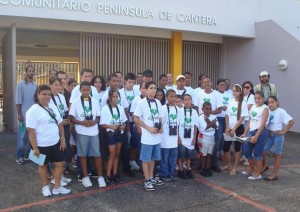
First Workshop: Geographical Perception
This workshop was led by Bárbara Rivera, Coordinator of Educational Programs. With a projector displaying the Cornell Lab of Ornithology website, she and a colleague walked twenty young participants through several conservation and research programs, and also started a discussion about what aspects of the Cantera Peninsula’s natural habitat were important for wildlife and the community. Through this dialogue, students were able to show what knowledge they already had and their areas of interest.

Second Workshop: Orientation
Participants went on a walk from the Community Center to the Neighborhood Council, during which they were able to experience certain areas of the Cantera Peninsula for the first time. These fifty-odd students then heard from Miguel Capaccetti, president of “Leaders for the World,” and Debbie Boneta, from InCiCo, who explained the presentations and activities that would comprise the program, and emphasized the importance of participant commitment to realizing the project’s goals.
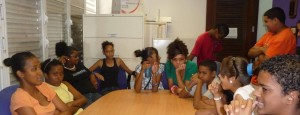
This question-and-answer session provided an active conversation with participants about Cantera Peninsula’s geography, the transformation of its community over time, the relationship between urban and natural areas, the pros and cons for birds living in urban areas, common bird species, and the importance of trees and home gardens to birds trying to survive in the city.
Fourth Workshop: The Relationship Between Birds and Trees
Here we continued our discussion of the reciprocal relationships between trees and birds, emphasizing the importance of enriching Cantera Peninsula’s urban areas with trees and plants that could provide food and shelter for birds. On this day’s bird walk, we tried to express:
- The importance and advantages of keeping quiet while looking for birds
- How to use guides to identify birds
- The ease of connection with the environment through observation

During the second stage of the workshop, we introduced the youth to basic techniques for tree and bush planting. We planted six trees and four bushes that would attract hummingbirds, which were donated by the Department of Natural Resources (DRNA) and the Puerto Rico University Botanical Garden, and also requested additional species for future reforestation projects. The DRNA generously donated nine species of tree for such an event, including two that are endemic and endangered in Puerto Rico.

An art teacher, Gloriela Muñoz, talked with students about the notable presence of birds in human history as it is expressed through artwork, culture, science, and language. She shared images from different countries and historical periods representing birds, comparing these graphical representations over culture and time to show the relevance of art in science as a method to record details of birds’ physical appearances. She emphasized the need to observe both general characteristics and details in birds to identify and draw them, explaining concepts of body proportion, contour lines, types of beak and feet, size and shapes of the head, wings, and tail, and colors of plumage as they relate to the birds’ habitats.
Mrs. Muñoz presented and described the art materials that would be used in the final event, and started showing participants how to sketch their projects with the help of photographs of common birds to Cantera Peninsula.
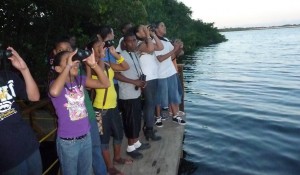
With a mix of Powerpoint presentations and time outdoors practicing, we discussed:
- The role and importance of citizen science
- The fundamentals of bird observation and its relevance as a recreational and scientific activity
- The key elements of looking at bird behavior and characteristics
- Basic techniques for identifying birds
- Correct use of binoculars and field guides
- The sixteen focal species of Celebrate Urban Birds
- Common birds of Cantera Peninsula
- How to record bird data in different ways
- The required methodology for CUBs that would be used during our event
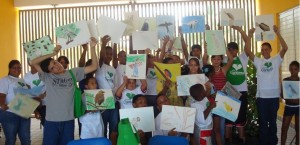
For eight hours on October 30th of 2010, between the breakfast, snacks, and lunch that we provided, over fifty participants and collaborators joined in on a day of fun and science. Members of the workshops received a t-shirt, notebook, pencil, and Cornell Lab of Ornithology materials to keep, and were divided into three groups with an adult supervisor to go out and observe some birds!
The three groups, Guaraguao (Red-tailed Hawk), Pitirre (Grey Kingbird), and Picaflor (Hummingbird) each were given a field guide, binoculars for each participant, and a digital camera to use for the day, which was a sunny, humid 89°F. Observation points were chosen to conduct the 10-minute stops, and later on everyone met up at the Community Center to share their experiences and data.
Of CUBs’ sixteen focal species, nine are residents or migrants in Puerto Rico (see the list below). Of these, the Rock Pigeon and the House Sparrow were the only ones seen, with 21 and 7 sightings, respectively.
- Barn Swallow (migratory, uncommon)
- Baltimore Oriole (migratory in winter, uncommon)
- Peregrine Falcon (migratory, common)
- Black-crowned Night Heron (resident, common)
- House Sparrow (resident, common)
- Killdeer (resident, common)
- Mourning Dove (resident, common)
- Rock Pigeon (resident, common)
- Mallard (often seen in captivity)
Of the total species seen, the most abundant were the Chango or Mozambique (Greater Antillean Grackle) at 45 individuals, the Paloma Casera (Rock Pigeon) at 21, and the Reinita Común (Bananaquit) at 20.
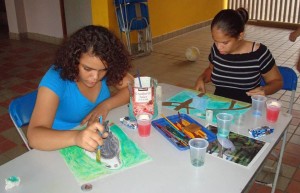
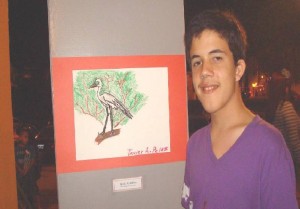
Gloriela Muñoz came back in November to help kids who had not yet finished their work or who wanted to add more details. Then she taught them how to use watercolors. A month later, at the Christmas events of Cantera Peninsula, several of these works of art where exhibited for the enjoyment of the whole community, and everyone appreciated a talent show with acting, music, dancing, and singing.
Our brief thoughts on the youth participants
- The response from our participants exceeded expectations both in number and quality of work demonstrated.
- The youngsters committed themselves to the process of preparation with much interest and identified with the project
- They paid due attention to activity directors and engaged in all activities
- They expressed interest in learning more about birds, and participating in similar activities involving environmental conservation and birdwatching in Cantera Peninsula